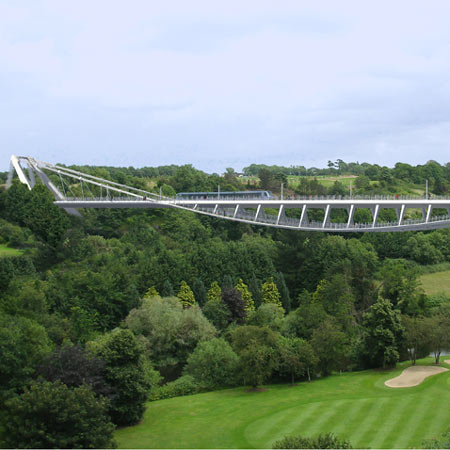Explorations Architecture of Paris with UK engineers Buro Happold have won a competition to design a new rail bridge over the Liffey Valley near Dublin, Ireland.
The winning design is a 350 metres long, 17 metres wide suspension bridge that will span the Liffey Valley 9 kilometres west of Dublin.
It will form part of the Metro West light rail system that will run from Thallagght, south-west of Dublin, to the airport in the north.
"The structure is designed to minimise any visual obstruction across the valley perspective," say Explorations Architecture.
Supports drop below the deck towards the middle of the bridge, affording passengers uninterrupted views of the valley.
The competition was organised by the Royal Institute of the Architects of Ireland.
Here's some more information from the architects:
--
METRO WEST LIGHT RAIL BRIDGE OVER THE LIFFEY VALLEY
DUBLIN, IRELAND
The proposed design is a cutting edge suspension bridge having a total length of approximately 350m. With its low rise towers and shallow cable profile, the bridge is an iconic yet subtle structure flying delicately over the Liffey Valley.
The Metro West Liffey Bridge will be the first significant suspension bridge in Ireland and a pioneering development in medium span railroad suspension systems. Its innovative outline will form a symbol for the Dublin light rail system contributing to its already outstanding European reputation, without compromising the natural setting.
The structure is designed to minimise any visual obstruction across the valley perspective. The site is an extremely delicate arena for some of nature’s finest achievements. A structure with multiple or heavy supports destroying the valley floor, or an egotistical statement that rises far above the mature tree height, would more than detract from this beautiful landscape. This lightweight minimalist approach allows the deck to smoothly emerge from the existing woodlands and integrate into the Liffey Valley.
The bridge is designed as a safe, efficient and durable structure, perfectly suited to a light rail crossing of this magnitude. Materials and construction technology have been carefully selected to provide low maintenance. Suspension bridges, as opposed to many other forms of long span structures, offer a balanced set of components. The masts, cables and deck integrate together to deliver a lightweight yet confident feel.
The bridge structure is designed to avoid all disruption to the valley floor from inception through to in-service operation. Not only are the sensitive ecological boundaries around the immediate river vicinity undisturbed throughout, but a construction free zone of more than 300m is possible. This will include the river, lower woodlands, Lower Lucan road and all existing structures.
This approach has been extended to the proposed pathways and landscaping that will pass below the bridge and develop a part of the concept of the “Liffey Valley park”. Several pathways with terraced steps, ramps and natural belvederes will run from each of the bridge abutments. These links will be constructed in a particularly subtle way in order to keep the bucolic ambiance of the site. Local materials such as stone, timber and rammed earth will all be integrated to form a pedestrian trail in the meadows along the Liffey. Several seasonal river crossings will also allow users to pass from one side of the valley to the other at low level. These are intended to be simple but safe crossings that further benefit the valley experience.
Views from the Metro West rail fleet will be unobstructed. The trains emerge from the woodland, pass through the tower gateway and reach the centre of the valley. They are greeted with clear lines of site, both upstream and downstream as the structural elements dive below to provide under deck support. Passengers and pedestrians alike will be able to admire the outstanding natural surrounds thanks to the almost transparent guardrails formed of horizontal wire infill. The guardrails not only offer a strong feeling of security, but allow unobstructed views for all users of the bridge.
Several natural routes overlooking the valley and bridge will be on the North and South slopes including one at the edge of the Hermitage hospital grounds and a viewing platform at the top of the North “Z” ramp. The views will look onto the fast flowing river with the bridge powering across, framed by the existing woodland. Benches will be installed to enjoy the unique setting.
Client
Railway Procurement Agency (RPA)
Competition organizer
Royal Institute of Irish Architects
Buro Happold, London
Design team: Adam Allegri, James Worth, Ella Barkham, Winfried Meijer, Davood Liaghat, Simon Fryer, Matthew Crouchman, Anthony Holder
+
Explorations architecture, Paris
Design team: Benoît le Thierry d’Ennequin, Yves Pagès, Sylvia Bauer
general information
Timeframe
Two stage competition from June to November 2008
Construction is anticipated in 2011-2012
Budget
50 M €
Location
Metro West Railway Bridge is crossing the Liffey Valley 9 km west of Dublin City Centre and 3 km east of Lucan village;
Function
The Metro West light rail system will run from Thallaght, south-west of Dublin city, to the Airport in the north.
Dimensions
Span: 350 m
Width: 17m
More Dezeen stories about Explorations Architecture:
.

